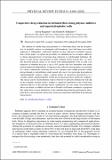Cooperative drag reduction in turbulent flows using polymer additives and superhydrophobic walls
Author(s)
Rajappan, Anoop; McKinley, Gareth H
DownloadPublished version (1.631Mb)
Publisher Policy
Publisher Policy
Article is made available in accordance with the publisher's policy and may be subject to US copyright law. Please refer to the publisher's site for terms of use.
Terms of use
Metadata
Show full item recordAbstract
© 2020 American Physical Society. The addition of soluble long chain polymers to a Newtonian fluid, and the incorporation of aerophilic textures on submerged solid boundaries, have both been successfully employed as independent, stand-alone methods for drag reduction in turbulent aqueous flows. In this paper, we explore the possibility of combining the two strategies additively to obtain enhanced levels of frictional drag reduction in wall-bounded turbulence. By means of skin friction measurements in fully turbulent Taylor-Couette flow, we show that dissolved polymer chains act in concert with superhydrophobic walls to yield a net reduction in turbulent drag that is up to 50% greater than that obtainable from either method employed independently. Cooperative drag reduction measurements are presented for various combinations involving one of two common water-soluble polymers (either polyacrylamide or polyethylene oxide) paired with one of two prototype drag-reducing superhydrophobic surfaces - either a regular pattern of streamwise microgrooves or a scalable random superhydrophobic texture possessing hierarchical multiscale roughness. The surface activity of polyethylene oxide is observed to adversely influence the wall slip on the randomly textured surface, leading to significant diminution in the overall drag reduction efficacy of this polymer-surface combination. In cases where such interfacial effects are absent, an additive friction law in Prandtl-von Kármán coordinates is proposed that yields fairly accurate predictions of the combined drag reduction performance anticipated from a given polymer-surface pair, each possessing known individual drag-reducing characteristics.
Date issued
2020-11Department
Hatsopoulos Microfluids Laboratory (Massachusetts Institute of Technology); Massachusetts Institute of Technology. Department of Mechanical EngineeringJournal
Physical Review Fluids
Publisher
American Physical Society (APS)
Citation
Rajappan, Anoop and McKinley, Gareth H. 2020. "Cooperative drag reduction in turbulent flows using polymer additives and superhydrophobic walls." Physical Review Fluids, 5 (11).
Version: Final published version
ISSN
2469-990X